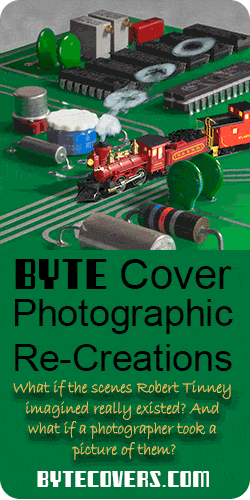
Here’s how I built a birdhouse with a webcam inside.
 One of my favorite blogs is Make Magazine‘s. There, I ran across an item about a person who had put a webcam inside a bird house. He is surely not the first person to do such a thing, but it was the first I had heard of it, and it inspired me to do the same.
One of my favorite blogs is Make Magazine‘s. There, I ran across an item about a person who had put a webcam inside a bird house. He is surely not the first person to do such a thing, but it was the first I had heard of it, and it inspired me to do the same.

I have a few bird houses around the yard, but some of them have never gotten feathered residents. One bird house, however, has had birds in it every year. It’s not big enough to hold a webcam, so I decided to build a new one, modeled on the old. This is a chickadee bird house, with an opening 1 3/8″ in diameter, placed about 4″ above the floor. The new bird house has the same width, and the same size opening placed at the same height above the floor. But it adds an attic to hold the webcam.

There are plenty of sites and plans available for building bird houses, so I’ll just note two things about the design. First, the roof extends an inch or two over the front, to shield the opening from rain. Second, there are gaps between the boards of the slanted floor and the vertical side walls to allow for ventilation.
In the old bird house, the flat floor is screwed in, and can easily be slid out. This allows access for cleaning the bird house in the fall, but it’s a small opening, and cleaning is difficult. For my new birdhouse, I made the entire roof removable by screwing it on instead of nailing it on. That provides access to the attic. The floor of the attic lifts out completely (it is not even screwed in; it is held in place by an extra piece of wood attached to the roof), so that I have a large opening through which to clean the bird house.



The camera looks like one built by Kinamax, the WCM-NVA, which is advertised as having six infra-red LEDs (and I presume it has no IR filter). That’s the camera I thought I was buying on eBay, but the camera I got had white light LEDs. I didn’t want those disturbing the birds, so I opened up the camera (fortunately, it’s held together by easily accessible screws), de-soldered the white LEDs, and installed IR LEDs. There was also an infrared filter that I removed. The LEDs I got have a 20° viewing angle. In retrospect, I should’ve gotten a 40° viewing angle; the current LEDs make too much of a concentrated spotlight.
To fasten the camera to the ceiling, I drilled a hole big enough for the lens and the ring of LEDs. The clip on the camera was easily removed with screws. I made the metal strap by bending a pipe bracket from the plumbing section of the hardware store. I put a thick, wide rubber band between the bracket and the camera to provide a springy force and friction to hold the camera in place.
The next step was to focus the camera, since it requires manual focusing, and once the birds have moved in, I dare not approach the bird house. I put the ceiling on, stuck a ruler through the door, and dangled it down to the approximate level of the birds. Then, I focused on the numbering on the ruler.

Before finally assembling the bird house, I needed to protect the camera from avian detritus. I cut a piece of tough plastic from a blister pack – those maddening plastic cases that everything you buy is wrapped in these days – and stapled it over the camera.
The bird house is mounted on a pole a few feet from the house. A USB extension cord snakes from the camera, in through a window, to the computer. I had briefly thought about having the bird house farther from the house and having a long USB cable strung up high, out of the way, but that could attract a lightning strike. A wireless camera was another possibility, but then I would’ve needed to get reliable power to it. Stringing a power cord across the lawn would be worse than stringing a USB cable. Finally, I could try a large battery recharged by solar cells, but that was more money than I cared to spend.
The USB cord dips beneath the window before coming up again and going inside. This ensures that rain doesn’t flow down he wire into the house. The window and screen are left open a crack, but the crack is covered with tape to stop bugs from getting in.
An old laptop computer running Windows XP and PY Software’s Active Web Cam Pro monitors the web cam, taking snapshot every 15 minutes and uploading them to this site as well as using motion detection to record videos when something interesting is happening.
